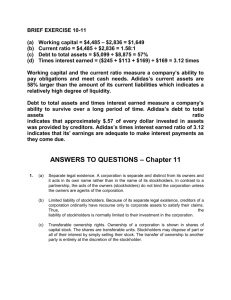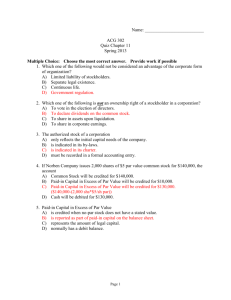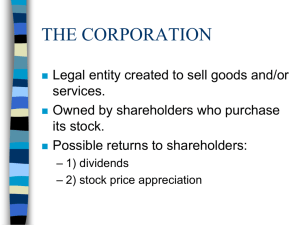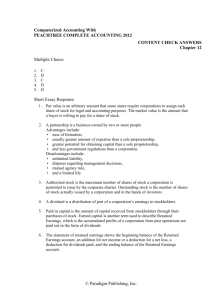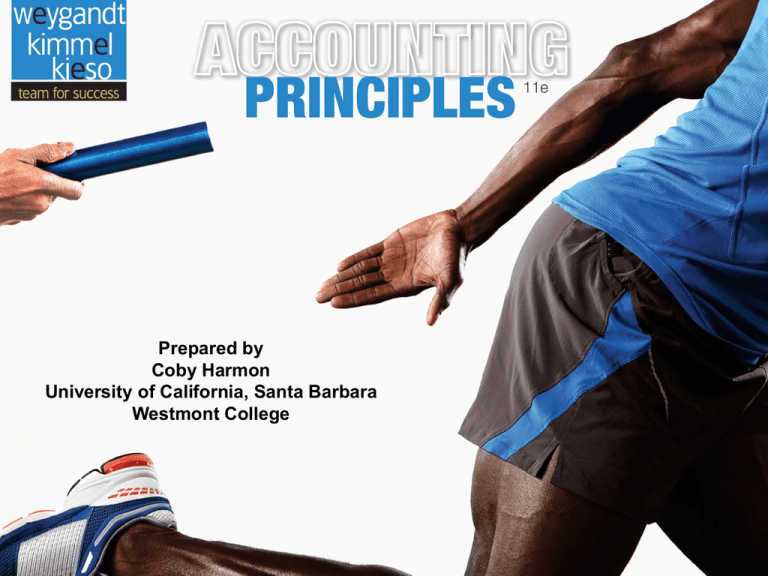
Prepared by
Coby Harmon
University of California, Santa Barbara
Westmont College
13-1
13
Corporations: Organization
and Capital Stock
Transactions
Learning Objectives
After studying this chapter, you should be able to:
[1] Identify the major characteristics of a corporation.
[2] Differentiate between paid-in capital and retained earnings.
[3] Record the issuance of common stock.
[4] Explain the accounting for treasury stock.
[5] Differentiate preferred stock from common stock.
[6] Prepare a stockholders’ equity section.
13-2
Preview of Chapter 13
Accounting Principles
Eleventh Edition
Weygandt Kimmel Kieso
13-3
The Corporate Form of Organization
An entity separate and distinct from its owners.
Classified by Purpose
Classified by Ownership
Not-for-Profit
Publicly held
For Profit
Privately held
►
Salvation Army
►
McDonald’s
►
American Cancer
Society
►
Nike
►
PepsiCo
►
Google
13-4
►
Cargill Inc.
Alternative Terminology
Privately held corporations
are also referred to as
closely held corporations.
LO 1 Identify the major characteristics of a corporation.
Characteristics of an Organization
Characteristics that distinguish corporations from
proprietorships and partnerships.
13-5
Separate Legal Existence
Limited Liability of Stockholders
Transferable Ownership Rights
Ability to Acquire Capital
Continuous Life
Corporate Management
Government Regulations
Additional Taxes
Advantages
Disadvantages
LO 1 Identify the major characteristics of a corporation.
Characteristics of an Organization
Characteristics that distinguish corporations from
proprietorships and partnerships.
Corporation acts
Separate Legal Existence
under its own name
rather than in the
Limited Liability of Stockholders
name of its
Transferable Ownership Rights
stockholders.
Ability to Acquire Capital
13-6
Continuous Life
Corporate Management
Government Regulations
Additional Taxes
LO 1 Identify the major characteristics of a corporation.
Characteristics of an Organization
Characteristics that distinguish corporations from
proprietorships and partnerships.
13-7
Separate Legal Existence
Limited Liability of Stockholders
Transferable Ownership Rights
Ability to Acquire Capital
Continuous Life
Corporate Management
Government Regulations
Additional Taxes
Limited to their
investment.
LO 1 Identify the major characteristics of a corporation.
Characteristics of an Organization
Characteristics that distinguish corporations from
proprietorships and partnerships.
13-8
Separate Legal Existence
Limited Liability of Stockholders
Transferable Ownership Rights
Ability to Acquire Capital
Continuous Life
Corporate Management
Government Regulations
Additional Taxes
Shareholders may
sell their stock.
LO 1 Identify the major characteristics of a corporation.
Characteristics of an Organization
Characteristics that distinguish corporations from
proprietorships and partnerships.
13-9
Separate Legal Existence
Limited Liability of Stockholders
Transferable Ownership Rights
Ability to Acquire Capital
Continuous Life
Corporate Management
Government Regulations
Additional Taxes
Corporation can
obtain capital
through the issuance
of stock.
LO 1 Identify the major characteristics of a corporation.
Characteristics of an Organization
Characteristics that distinguish corporations from
proprietorships and partnerships.
13-10
Separate Legal Existence
Limited Liability of Stockholders
Transferable Ownership Rights
Ability to Acquire Capital
Continuous Life
Corporate Management
Government Regulations
Additional Taxes
Continuance as a
going concern is not
affected by the
withdrawal, death, or
incapacity of a
stockholder,
employee, or officer.
LO 1 Identify the major characteristics of a corporation.
Characteristics of an Organization
Characteristics that distinguish corporations
from proprietorships and partnerships.
13-11
Separate Legal Existence
Limited Liability of Stockholders
Transferable Ownership Rights
Ability to Acquire Capital
Continuous Life
Corporate Management
Government Regulations
Additional Taxes
Separation of
ownership and
management
prevents owners
from having an
active role in
managing the
company.
LO 1 Identify the major characteristics of a corporation.
Characteristics of an Organization
Characteristics that distinguish corporations from
proprietorships and partnerships.
13-12
Separate Legal Existence
Limited Liability of Stockholders
Transferable Ownership Rights
Ability to Acquire Capital
Continuous Life
Corporate Management
Government Regulations
Additional Taxes
LO 1 Identify the major characteristics of a corporation.
Characteristics of an Organization
Characteristics that distinguish corporations from
proprietorships and partnerships.
13-13
Separate Legal Existence
Limited Liability of Stockholders
Transferable Ownership Rights
Ability to Acquire Capital
Continuous Life
Corporate Management
Government Regulations
Additional Taxes
Corporations pay
income taxes as a
separate legal entity
and in addition,
stockholders pay
taxes on cash
dividends.
LO 1 Identify the major characteristics of a corporation.
Characteristics of an Organization
Stockholders
Illustration 13-1
Corporation
organization chart
Chairman and
Board of
Directors
President and
Chief Executive
Officer
General
Counsel/
Secretary
Vice President
Finance/Chief
Financial Officer
Vice President
Marketing
Treasurer
13-14
Vice President
Operations
Vice President
Human
Resources
Controller
LO 1 Identify the major characteristics of a corporation.
The Corporate Form of Organization
Forming a Corporation
Initial Steps:
Alternative Terminology
The charter is often
referred to as the articles
of incorporation.
File application with the Secretary of State.
State grants charter.
Corporation develops by-laws.
Companies generally incorporate in a state whose laws are
favorable to the corporate form of business (Delaware, New Jersey).
Corporations engaged in interstate commerce must obtain a license
from each state in which they do business.
13-15
LO 1 Identify the major characteristics of a corporation.
The Corporate Form of Organization
Stockholders Rights
Illustration 11-3
1. Vote in election of board of
directors and on actions that
require stockholder approval.
2. Share the corporate earnings
through receipt of dividends.
13-16
LO 1 Identify the major characteristics of a corporation.
The Corporate Form of Organization
Stockholders Rights
Illustration 11-3
3. Keep the same percentage ownership when new shares
of stock are issued (preemptive right).
* A number of companies have eliminated the preemptive right.
13-17
LO 1 Identify the major characteristics of a corporation.
The Corporate Form of Organization
Stockholders Rights
Illustration 11-3
4. Share in assets upon liquidation in proportion to their
holdings. This is called a residual claim.
13-18
LO 1 Identify the major characteristics of a corporation.
13-19
Stock Issue Considerations
Authorized Stock
Charter indicates the amount of stock that a
corporation is authorized to sell.
Number of authorized shares is often reported in the
stockholders’ equity section.
13-20
LO 1 Identify the major characteristics of a corporation.
Stock Issue Considerations
Prenumbered
Shares
Illustration 13-4
Name of corporation
Stockholder’s
name
Signature of
corporate official
13-21
LO 1
Stock Issue Considerations
Issuance of Stock
Corporation can issue common stock directly to investors
or indirectly through an investment banking firm.
Factors in setting price for a new issue of stock:
1. Company’s anticipated future earnings.
2. Expected dividend rate per share.
3. Current financial position.
4. Current state of the economy.
5. Current state of the securities market.
13-22
LO 1 Identify the major characteristics of a corporation.
Stock Issue Considerations
Market Price of Stock
13-23
Stock of publicly held companies is traded on organized
exchanges.
Interaction between buyers and sellers determines the prices
per share.
Prices tend to follow the trend of a company’s earnings and
dividends.
Factors beyond a company’s control, may cause day-to-day
fluctuations in market prices.
LO 1 Identify the major characteristics of a corporation.
13-24
Stock Issue Considerations
Par and No-Par Value Stock
13-25
Years ago, par value determined the legal capital per share
that a company must retain in the business for the protection
of corporate creditors.
Today many states do not require a par value.
No-par value stock is quite common today.
In many states the board of directors assigns a stated value to
no-par shares.
LO 1 Identify the major characteristics of a corporation.
Stock Issue Considerations
Question
Which of these statements is false?
a. Ownership of common stock gives the owner a voting
right.
b. The stockholders’ equity section begins with paid-in
capital.
c. The authorization of capital stock does not result in a
formal accounting entry.
d. Legal capital is intended to protect stockholders.
13-26
LO 1 Identify the major characteristics of a corporation.
>
DO IT!
Indicate whether each of the following statements is true or false.
False 1. Similar to partners in a partnership, stockholders of a
______
corporation have unlimited liability.
True 2. It is relatively easy for a corporation to obtain capital
______
through the issuance of stock.
False 3. The separation of ownership and management is an
______
advantage of the corporate form of business.
False 4. The journal entry to record the authorization of capital stock
______
includes a credit to the appropriate capital stock account.
False 5. All states require a par value per share for capital stock.
______
13-27
LO 1 Identify the major characteristics of a corporation.
Corporate Capital
Common Stock
Account
Paid-in Capital
Preferred Stock
Paid-in Capital in
Excess of Par
Account
Account
Two Primary
Sources of
Equity
Retained Earnings
Account
Paid-in capital is the total amount of cash and other assets paid in
to the corporation by stockholders in exchange for capital stock.
13-28
LO 2 Differentiate between paid-in capital and retained earnings.
Corporate Capital
Common Stock
Account
Paid-in Capital
Preferred Stock
Paid-in Capital in
Excess of Par
Account
Account
Two Primary
Sources of
Equity
Retained Earnings
Account
Retained earnings is net income that a corporation retains for
future use.
13-29
LO 2 Differentiate between paid-in capital and retained earnings.
Corporate Capital
Comparison of the owners’ equity (stockholders’ equity)
accounts reported on a balance sheet for a proprietorship, a
partnership, and a corporation.
Illustration 13-6
13-30
LO 2 Differentiate between paid-in capital and retained earnings.
13-31
Accounting for Common Stock Issues
Primary objectives:
1) Identify the specific sources of paid-in capital.
2) Maintain the distinction between paid-in capital and
retained earnings.
Other than consideration received, the issuance
of common stock affects only paid-in capital
accounts.
13-32
LO 3 Record the issuance of common stock.
Accounting for Common Stock Issues
Issuing Par Value Common Stock for Cash
Illustration: Assume that Hydro-Slide, Inc. issues 1,000 shares of
$1 par value common stock. Prepare Hydro-Slide’s journal entry if
(a) 1,000 share are issued for $1 per share, and (b) 1,000 shares
are issued for $5 per share.
a.
Cash
1,000
Common Stock (1,000 x $1)
b.
13-33
Cash
1,000
5,000
Common Stock (1,000 x $1)
1,000
Paid-in Capital in Excess of Par Value
4,000
LO 3 Record the issuance of common stock.
Accounting for Common Stock Issues
Illustration 13-7
13-34
Alternative Terminology
Paid-in Capital in Excess of
Par is also called Premium
on Stock.
LO 3 Record the issuance of common stock.
Accounting for Common Stock Issues
Issuing Common Stock for Services or
Noncash Assets
Corporations also may issue stock for:
Services (attorneys or consultants).
Noncash assets (land, buildings, and equipment).
Cost is either the fair market value of the consideration
given up, or the fair market value of the consideration
received, whichever is more clearly determinable.
13-35
LO 3 Record the issuance of common stock.
Accounting for Common Stock Issues
Illustration: Attorneys have helped Jordan Company incorporate.
They have billed the company $5,000 for their services. They agree
to accept 4,000 shares of $1 par value common stock in payment of
their bill. At the time of the exchange, there is no established
market price for the stock. Prepare the journal entry for this
transaction.
Organizational Expense
13-36
5,000
Common Stock (4,000 x $1)
4,000
Paid-in Capital in Excess of par
1,000
LO 3 Record the issuance of common stock.
Accounting for Common Stock Issues
Illustration: Athletic Research Inc. is an existing publicly held
corporation. Its $5 par value stock is actively traded at $8 per
share. The company issues 10,000 shares of stock to acquire land
recently advertised for sale at $90,000. Prepare the journal entry for
this transaction.
Land (10,000 x $8)
13-37
80,000
Common Stock (10,000 x $5)
50,000
Paid-in Capital in Excess of Par
30,000
LO 3 Record the issuance of common stock.
ANATOMY OF A FRAUD
The president, chief operating officer, and chief financial officer of SafeNet, a software
encryption company, were each awarded employee stock options by the company’s board of
directors as part of their compensation package. Stock options enable an employee to buy a
company’s stock sometime in the future at the price that existed when the stock option was
awarded. For example, suppose that you received stock options today, when the stock price of
your company was $30. Three years later, if the stock price rose to $100, you could “exercise”
your options and buy the stock for $30 per share, thereby making $70 per share. After being
awarded their stock options, the three employees changed the award dates in the company’s
records to dates in the past, when the company’s stock was trading at historical lows. For
example, using the previous example, they would choose a past date when the stock was
selling for $10 per share, rather than the $30 price on the actual award date. In our example,
this would increase the profit from exercising the options to $90 per share.
Total take: $7 billion
THE MISSING CONTROLS
Independent internal verification. The company’s board of directors should have
ensured that the awards were properly administered. For example, the date on the
minutes from the board meeting could be compared to the dates that were recorded
for the awards. In addition, the dates should again be confirmed upon exercise.
13-38
Advance slide in presentation mode to reveal answer.
Accounting for Treasury Stock
Common Stock
Account
Paid-in Capital
Preferred Stock
Paid-in Capital in
Excess of Par
Account
Account
Two Primary
Sources of
Equity
Retained Earnings
Account
Less:
Treasury Stock
Account
13-39
LO 4 Explain the accounting for treasury stock.
Accounting for Treasury Stock
Treasury stock - corporation’s own stock that it has
reacquired from shareholders, but not retired.
Corporations purchase their outstanding stock:
1. To reissue the shares to officers and employees under bonus
and stock compensation plans.
2. To enhance the stock’s market value.
3. To have additional shares available for use in the acquisition of
other companies.
4. To increase earnings per share.
13-40
LO 4 Explain the accounting for treasury stock.
Accounting for Treasury Stock
Purchase of Treasury Stock
Debit Treasury Stock for the price paid to reacquire the
shares.
Treasury stock is a contra stockholders’ equity account,
not an asset.
Purchase of treasury stock reduces stockholders’
equity.
Helpful Hint Treasury
shares do not have dividend
rights or voting rights.
13-41
LO 4 Explain the accounting for treasury stock.
Accounting for Treasury Stock
Illustration 13-8
Illustration: On February 1, 2014, Mead acquires 4,000 shares of
its stock at $8 per share.
Treasury Stock (4,000 x $8)
Cash
13-42
32,000
32,000
LO 4 Explain the accounting for treasury stock.
Accounting for Treasury Stock
Illustration 13-9
Stockholders’ equity
with treasury stock
Both the number of shares issued
(100,000), outstanding (96,000), and the
number of shares held as treasury (4,000)
are disclosed.
13-43
LO 4 Explain the accounting for treasury stock.
13-44
Accounting for Treasury Stock
Disposal of Treasury Stock
Sale of Treasury Stock
Above Cost
Below Cost
Helpful Hint Treasury stock
transactions are classified as
capital stock transactions.
As in the case when stock
is issued, the income
statement is not involved.
Both increase total assets and stockholders’ equity.
13-45
LO 4 Explain the accounting for treasury stock.
Accounting for Treasury Stock
Above
Cost
Illustration: On July 1, Mead sells for $10 per share 1,000
shares of its treasury stock, previously acquired at $8 per share.
July 1 Cash
10,000
Treasury Stock
8,000
Paid-in Capital Treasury Stock
2,000
A corporation does not realize a gain or suffer a loss from stock
transactions with its own stockholders.
13-46
LO 4 Explain the accounting for treasury stock.
Accounting for Treasury Stock
Below
Cost
Illustration: On Oct. 1, Mead sells an additional 800 shares of
treasury stock at $7 per share.
Oct. 1 Cash
5,600
Paid-in Capital Treasury Stock
Treasury Stock
800
6,400
Illustration 13-10
13-47
LO 4 Explain the accounting for treasury stock.
Accounting for Treasury Stock
Below
Cost
Illustration: On Dec. 1, assume that Mead, Inc. sells its
remaining 2,200 shares at $7 per share.
Dec. 1 Cash
Paid-in Capital Treasury Stock
1,200
Retained Earnings
1,000
Treasury Stock
13-48
15,400
Limited
to
balance
on
hand
17,600
LO 4 Explain the accounting for treasury stock.
Preferred Stock
Features often associated with preferred stock.
1.
Preference as to dividends.
2.
Preference as to assets in liquidation.
3.
Nonvoting.
Accounting for preferred stock at issuance is similar to that for
common stock.
13-49
LO 5 Differentiate preferred stock from common stock.
Preferred Stock
Illustration: Stine Corporation issues 10,000 shares of $10
par value preferred stock for $12 cash per share. Journalize
the issuance of the preferred stock.
Cash
120,000
Preferred Stock (10,000 x $10)
Paid-in Capital in Excess of Par –
Preferred Stock
100,000
20,000
Preferred stock may have a par value or no-par value.
13-50
LO 5 Differentiate preferred stock from common stock.
Preferred Stock
Dividend Preferences
Right to receive dividends before common stockholders.
Per share dividend amount is stated as a percentage of the
preferred stock’s par value or as a specified amount.
Cumulative dividend – holders of preferred stock must be
paid their annual dividend plus any dividends in arrears
before common stockholders receive dividends.
13-51
LO 5 Differentiate preferred stock from common stock.
Preferred Stock
Cumulative Dividend
Illustration: Scientific Leasing has 5,000 shares of 7%, $100 par
value, cumulative preferred stock outstanding. Each $100 share
pays a $7 dividend (.07 x $100). The annual dividend is $35,000
(5,000 x $7 per share). If dividends are two years in arrears,
preferred stockholders are entitled to receive the following
dividends in the current year.
Illustration 13-11
13-52
LO 5 Differentiate preferred stock from common stock.
Preferred Stock
Liquidation Preferences
Most preferred stocks have a preference on corporate
assets if the corporation fails.
Provides security for the preferred stockholder.
Preference to assets may be for the par value of the
shares or for a specified liquidating value.
13-53
LO 5 Differentiate preferred stock from common stock.
Statement Presentation
Illustration 13-12
13-54
LO 6 Prepare a stockholders’ equity section.
A Look at IFRS
Key Points
13-55
Under IFRS, the term reserves is used to describe all equity accounts
other than those arising from contributed (paid-in) capital. This would
include, for example, reserves related to retained earnings, asset
revaluations, and fair value differences.
Many countries have a different mix of investor groups than in the United
States. For example, in Germany, financial institutions like banks are not
only major creditors of corporations but often are the largest corporate
stockholders as well. In the United States, Asia, and the United
Kingdom, many companies rely on substantial investment from private
investors.
LO 7 Compare the accounting procedures for
stockholders’ equity under GAAP and IFRS.
A Look at IFRS
Key Points
13-56
There are often terminology differences for equity accounts. The
following summarizes some of the common differences in terminology.
LO 7 Compare the accounting procedures for
stockholders’ equity under GAAP and IFRS.
A Look at IFRS
Key Points
13-57
The accounting for treasury stock differs somewhat between IFRS and
GAAP. (However, many of the differences are beyond the scope of this
course.) Like GAAP, IFRS does not allow a company to record gains or
losses on purchases of its own shares. One difference worth noting is
that, when a company purchases its own shares, IFRS treats it as a
reduction of stockholders’ equity, but it does not specify which particular
stockholders’ equity accounts are to be affected. Therefore, it could be
shown as an increase to a contra equity account (Treasury Stock) or a
decrease to retained earnings or share capital.
LO 7 Compare the accounting procedures for
stockholders’ equity under GAAP and IFRS.
A Look at IFRS
Key Points
13-58
A major difference between IFRS and GAAP relates to the account
Revaluation Surplus. Revaluation surplus arises under IFRS because
companies are permitted to revalue their property, plant, and equipment
to fair value under certain circumstances. This account is part of general
reserves under IFRS and is not considered contributed capital.
IFRS often uses terms such as retained profits or accumulated profit or
loss to describe retained earnings. The term retained earnings is also
often used.
Equity is given various descriptions under IFRS, such as shareholders’
equity, owners’ equity, capital and reserves, and shareholders’ funds.
LO 7 Compare the accounting procedures for
stockholders’ equity under GAAP and IFRS.
A Look at IFRS
Looking to the Future
As indicated in earlier discussions, the IASB and the FASB are currently
working on a project related to financial statement presentation. An important
part of this study is to determine whether certain line items, subtotals, and
totals should be clearly defined and required to be displayed in the financial
statements.
13-59
LO 7 Compare the accounting procedures for
stockholders’ equity under GAAP and IFRS.
A Look at IFRS
IFRS Self-Test Questions
Under IFRS, a purchase by a company of its own shares is recorded
by:
a) an increase in Treasury Stock.
b) a decrease in contributed capital.
c) a decrease in share capital.
d) All of these are acceptable treatments
13-60
LO 7 Compare the accounting procedures for
stockholders’ equity under GAAP and IFRS.
A Look at IFRS
IFRS Self-Test Questions
Which of the following is true?
a) In the United States, the primary corporate stockholders are
financial institutions.
b) Share capital means total assets under IFRS.
c) The IASB and FASB are presently studying how financial
statement information should be presented.
d) The amount to treasury stock is very different between U.S.
GAAP and IFRS.
13-61
LO 7 Compare the accounting procedures for
stockholders’ equity under GAAP and IFRS.
A Look at IFRS
IFRS Self-Test Questions
Under IFRS, the amount of capital received in excess of par value
would be credited to:
a) Retained Earnings.
b) Contributed Capital.
c) Share Premium.
d) Par value is not used under IFRS.
13-62
LO 7 Compare the accounting procedures for
stockholders’ equity under GAAP and IFRS.
Copyright
“Copyright © 2013 John Wiley & Sons, Inc. All rights reserved.
Reproduction or translation of this work beyond that permitted in
Section 117 of the 1976 United States Copyright Act without the
express written permission of the copyright owner is unlawful.
Request for further information should be addressed to the
Permissions Department, John Wiley & Sons, Inc. The purchaser
may make back-up copies for his/her own use only and not for
distribution or resale. The Publisher assumes no responsibility for
errors, omissions, or damages, caused by the use of these
programs or from the use of the information contained herein.”
13-63





